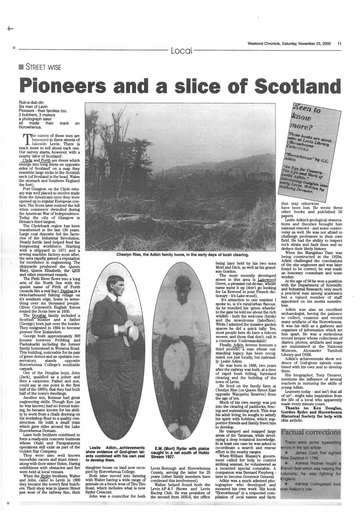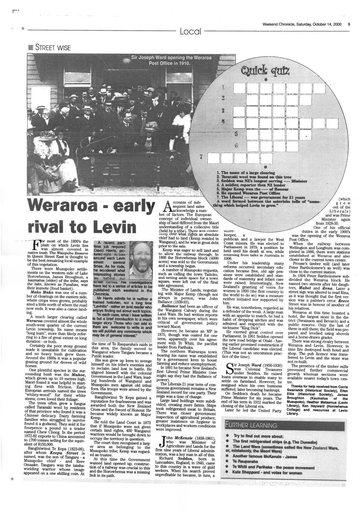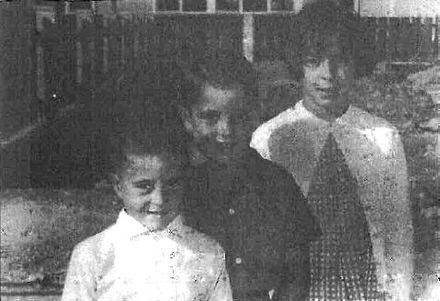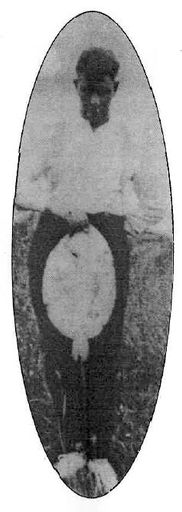This article is the thirteenth and final one in a series covering the streets of Levin and its immediate surrounds. The final collection is not confined to a particular area, rather they are those whose stories, by and large, have been rather more challenging to discover.
 Photo at left: Postcard with Early - about 1909 - views of Levin including (top right) The Avenue - the surrounding ferns and forest of matai and tawa explain the origins of the name.
Photo at left: Postcard with Early - about 1909 - views of Levin including (top right) The Avenue - the surrounding ferns and forest of matai and tawa explain the origins of the name.
Thomas Morgan was a local dairy farmer whose parents had migrated from the UK arriving in Wellington in 1842. He married Mathilda Brown, whose father David, a Tawa grazier, owned hundreds of acres on Kapiti Island. Her mother Rangiuira was of chiefly descent.
The family brought the former Bartholomew homestead in 1907, occupying it for most of the 20th century.
One of their sons was David, who at 16 signed up for the Anglo-Boer War, saying he was two years older. The riding, and shooting skills gained from his country upbringing, were apparently seen as primary qualifications for volunteers.
He and his wife Charlotte later took over the family home. Their nephew Mick Wilton says that there is a "strong possibility" that Morgan Crescent is named after the family.
Annie and Stan Green were also dairy farmers who subdivided their land around the same time, the early 1960's. Rae Corlett recalls the many young families in the street's early days; a steady stream walking to East School, and the off-street reserve well used after School and on weekends.
Some years earlier Frank Wilton had recruited suppliers over the lower half of the North Island for butter and cheese manufacturing at the Otaki Dairy Company. His farming and accounting experience apparently fitted him well for the manager's role. Corrie Swanwick suggests the street may be named after him and Power is possibly then name of the contractor who subdivided the Wilton Block.
Martin Harvey, and three of his brothers, Howard, Arthur and Joffre, continued the furniture making and funeral director's business established by their father. The former, premises, near the Samoan Assembly of God in Cambridge Street, was only demolished in recent months.
Martin Harvey was a cricket and tennis lover, volunteer fireman and, for a time, deputy mayor.
Another who held this office was Nepia Winiata . A highly successful student of Te Aute College in his youth, he later served as a Translator for the courts and president of the Otaki Maori Racing Club.
A number, of the eight Winiata brothers possessed formidable rugby talent: particularly Nepia himself, Walter (the "gentle giant"), Tommy Toha (who "ran like a hare") and Martin, who could have been an All Black according to Neville Winiata.
Dellys Campbell was another local who loved the outdoors, particularly skiing and tramping, according to her mother Cath. Bob Campbell formerly a woodwork teacher and borough councillor here, developed the land off Queen Street East and named it after one of his daughters, who was a head girl of Horowhenua College. Interestingly the Campbells' other daughter is named Roslyn - no connection with that street though!
For many people the name of Rugby School is immediately associated with the origins of the oval ball game. In British eyes, however, the 'school' was in the highest class of public schooling under the 19th century leadership of Thomas Arwold.
Another centuries-old school is Harrow, near London, which is distinctive for its own version of football and a traditional school- yard roll call. Its famous ex-pupils include Winston Churchill and Robert Peel, founder of the modern police force.
Eton, where a. number of modern Royals have educated, draws pupils from many of England's wealthiest .families. Basic annual fees exceed $40,000 and the uniform includes top hat and tails.
A town soaked in tradition is Guilford, the ancient capital of Surrey. Amidst a cobbled High Street and historic buildings, one of the most impressive sights is the pink-bricked cross-shaped Cathedral of the Holy Spirit built in 1961. Lewis Carroll – author of Alice inWonderland - lived in the town.
St Anne is the name traditionally given to the grandmother of Jesus Christ (through his Mother, Mary), though this detail lacks the his torical evidence that the rest of his life has.
It was the inspiration of Christ's life - With its announcement that mankind's self-will and wrong doing can be both forgiven and changed - that took Scotsman David Livingstone to Africa. And the lack of news about him for many years, caused the New York Herald to send Henry Morton Stanley to find him.
Stanley became the greatest European explorer of the Dark Continent – crossing from east to weat being his most significant achievement.
According to Corrie Swanwick, this street is likely to be named after the adventurer. The fact that Stanley's fame was greatest in the decades following 1870, the probable era of the street's naming, fits this assertion.
There are two local streets which commemorate others who left Britain for distant shores.
- Fairholme Place's name was chosen by the residents there for Andy and Annie Phair, whose home there was built by Jack Allen. Irishman Andy Phair arrived in this country in 1954. working first as a Foxton apiarist and later as a Clerk of Kimberly Hospital.
- Penny Griffiths worked there too as an occupational therapist, after migrating from England: She had been an ambulance driver during The Blitz of World War 11; she earnt her name Penny from a severe reaction to penicillin. She was involved with the Girl Guides movement for over 50 years and was a much loved leader: in Levin for at least 12. According to Carol Doreen, she was marvellously inventive with handcrafts and her weekend "Pack holidays" were as memorable as they were exciting. Archivist Wendy Rolls mentions a highlight for this devoted Brown Owl was to be picked. out of the throng by Lady Baden-Powell for a conversation in a 1967 visit.
After these tales, some very brief details remain to complete the series.
Awatea means daylight or "of the day". Beechwood was chosen by Paul Tucker to blend in with surrounding streets. Central, South and North lanes have obvious meanings; South Lane was a great source of weed-free gravel when the railway was constructed (hence the clip in the road). Rosedale Place was named in honour of a Wellington boarding house, formerly run by the grandmother of developer Brian Carruthers.
Homewood Avenue was named after another street!
Surveyor. Michael Truebriclge borrowed it from one of the wealthiest parts of Karori, Wellington. Linley Place was subdivided by Stan Read but I’m not sure why he chose that name.
The paddocks along part of Meadowvale Drive suggest the likely reasoning of the name, but where is the vale?
Another meaning of vale, pronounced “Vahlay” is farewell. Perhaps that’s it? (The disappearing meadow).
Leta maw e mtu u2Lp1ii.u.t itu w tutu %Amy .u.L each. step. In his own words, he transformed shearing from a "tough menial sweat into a great agri-cultural skill." He was invited to teach it in nearly every sheep nation on earth. At Expo 70 (the world fair held in Japan) he demonstrated his skill before 120,000 people. On his return he established a agrodome in Roslyn Road before resiting to Rotorua. •Reeve Street was named for Arthur Reeve whose daughter Elma married Elsdon Clark. Born in,England, Mr Reeve would likely have worked at Bartholomew's mill according to Maud Hinde; he was also a farm manager for Fred Roe. 'Mick Wilton recently showed me a photo of a "kangaroo stockade" in front of the Morgan (formerly Bartholomew) homestead. According to the 1968 obituary of his uncle Dave Morgan, the kangaroos were owned by Peter Bartholomew. Apparently they escaped over the 12 foot fence. There seems to be some disagreement as to whether they were recaptured or killed. 0 0 Thanks to the following people for informa-tion: .Mick Wilton, Leonie Gormanley and Margaret Allen (re Morgans), Janet Tillson, Wendy Rolls and Carrol Doreen (re Penny Griffiths), Maureen Young (re Phair Family), Neville Wmiata, Rae Corlett (re Green Family), Carrie Swanwick (re Stanley and others), Brian Carruthers (re Rosedale Place), Joffre and Doreen Harvey •(re Martin Harvey Street),• Cath•Campbell, BillCrighton (re Linley Place), Michael Truebridge,, Paul Tucker, Robin Barrie.
In his own words, he transformed shearing from a "tough menial sweat into a great agri-cultural skill." He was invited to teach it in nearly every sheep nation on earth. At Expo 70 (the world fair held in Japan) he demonstrated his skill before 120,000 people. On his return he established a agrodome in Roslyn Road before resiting to Rotorua. •Reeve Street was named for Arthur Reeve whose daughter Elma married Elsdon Clark. Born in,England, Mr Reeve would likely have worked at Bartholomew's mill according to Maud Hinde; he was also a farm manager for Fred Roe. 'Mick Wilton recently showed me a photo of a "kangaroo stockade" in front of the Morgan (formerly Bartholomew) homestead. According to the 1968 obituary of his uncle Dave Morgan, the kangaroos were owned by Peter Bartholomew. Apparently they escaped over the 12 foot fence. There seems to be some disagreement as to whether they were recaptured or killed. 0 0 Thanks to the following people for informa-tion: .Mick Wilton, Leonie Gormanley and Margaret Allen (re Morgans), Janet Tillson, Wendy Rolls and Carrol Doreen (re Penny Griffiths), Maureen Young (re Phair Family), Neville Wmiata, Rae Corlett (re Green Family), Carrie Swanwick (re Stanley and others), Brian Carruthers (re Rosedale Place), Joffre and Doreen Harvey •(re Martin Harvey Street),• Cath•Campbell, BillCrighton (re Linley Place), Michael Truebridge,, Paul Tucker, Robin Barrie.
have room for their done district court-cil. 0A building boom in Easton Way; very few sec-tions still unsold at the empty end. @A Pink Batts flag atop a newly-constructed Matipo Street home - celebrating completion of the roof? e The first signs of change on the vacant land in Vincent Drive: the paddock next to UCOL has been mowed and the fence removed. A neighbour-hood park, linked to Easton Way and Martin Harvey Street is being established here. e Quite a num-ber of youths dri-ving around town who can't afford-their own vehicles but not, as yet, padding for the seats or mufflers..
mgby and the like. Well
Remember usinvour Will and lem a legacy of hope Formoré information call 01100 53 00.00
. ' rillint*reanfolilis,
a*43 Apptheri* it:FAO 'r.t' etAtibtlItik:09 Ankokit-Ohili; 74 flit .".
.. Leta maw e mtu u2Lp1ii.u.t itu w tutu %Amy .u.L each. step. In his own words, he transformed shearing from a "tough menial sweat into a great agri-cultural skill." He was invited to teach it in nearly every sheep nation on earth. At Expo 70 (the world fair held in Japan) he demonstrated his skill before 120,000 people. On his return he established a agrodome in Roslyn Road before resiting to Rotorua. •Reeve Street was named for Arthur Reeve whose daughter Elma married Elsdon Clark. Born in,England, Mr Reeve would likely have worked at Bartholomew's mill according to Maud Hinde; he was also a farm manager for Fred Roe. 'Mick Wilton recently showed me a photo of a "kangaroo stockade" in front of the Morgan (formerly Bartholomew) homestead. According to the 1968 obituary of his uncle Dave Morgan, the kangaroos were owned by Peter Bartholomew. Apparently they escaped over the 12 foot fence. There seems to be some disagreement as to whether they were recaptured or killed. 0 0 Thanks to the following people for informa-tion: .Mick Wilton, Leonie Gormanley and Margaret Allen (re Morgans), Janet Tillson, Wendy Rolls and Carrol Doreen (re Penny Griffiths), Maureen Young (re Phair Family), Neville Wmiata, Rae Corlett (re Green Family), Carrie Swanwick (re Stanley and others), Brian Carruthers (re Rosedale Place), Joffre and Doreen Harvey •(re Martin Harvey Street),• Cath•Campbell, BillCrighton (re Linley Place), Michael Truebridge,, Paul Tucker, Robin Barrie.
How do we know this?
Stanley became the greatest European explorer of the Dark Continent - crossing from east to west being his most significant achieve-ment
According to Conie Swanwick, this street is likely to be named after the adventurer. The fact that .Stanley's fame was greatest in the decades. following 1870, the probable era of the street's. naming, fits this assertion.
There-ire two local streets which commem-orate others who left Britain for distant ;shores:
- Fairholme Place's name was chosen by the . residents there for Andy and Annie Phair, whose home there was built by Jack Allen. Irishman Andy Phair arrived in this country in 1954. working first as a Foxton apiarist and later as a Clerk of Kimberly Hospital.
- Penny Griffiths worked there too as an occupational therapist, after migrating from England: She had been an ambulance driver
 Photo at left: James Prouse, councillor, Dairy Company chairman, and pioneer sawmiller. He played a key role in early Levin; water race construction, fire brigade establishment and the beginnings of the methodist Church here.
Photo at left: James Prouse, councillor, Dairy Company chairman, and pioneer sawmiller. He played a key role in early Levin; water race construction, fire brigade establishment and the beginnings of the methodist Church here.
Do, you remember an earlier article in this series which mentioned Emma (Daisy) Bowen, that much-admired woman of early Levin? Well it was all true except for one fact - Bowen Street, wasn't named after her!
I'm thankful, however, to have had the opportunity of mentioning such a colourful personality.
Godfrey Bowen (no relation apparently), was even more widely known and lived here for 27 years. In 1953 he established a world shearing record - 456 full wool sheep in nine hours.
He was the first shearer to put together a technique and explain the how and why of each step.
In his own words, he transformed shearing from a "tough menial sweat into a great agricultural skill. "
He was invited to teach it in nearly every sheep nation on earth.
At Expo 70 (the world fair held in Japan) he demonstrated his skill before 120,000 people. On his return he established an agrodome in Roslyn Road before resiting to Rotorua. Reeve Street was named for Arthur Reeve whose daughter Elma married Elsdon Clark. Born in England, Mr Reeve would likely have worked at Bartholomew's mill according to Maud Hinde; he was also a farm manager for Fred Roe. Mick Wilton recently showed me a photo of a "kangaroo stockade" in front of the Morgan (formerly Bartholomew) homestead. According to the 1968 obituary of his uncle Dave Morgan, the kangaroos were owned by Peter Bartholomew. Apparently they escaped over the 12 foot fence. There seems to be some disagreement as to whether they were recaptured or killed.
Thanks to the following people for information: .Mick Wilton, Leonie Gormanley and Margaret Allen (re Morgans), Janet Tillson, Wendy Rolls and Carrol Doreen (re Penny Griffiths), Maureen Young (re Phair Family), Neville Winiata, Rae Corlett (re Green Family), Carrie Swanwick (re Stanley and others), Brian Carruthers (re Rosedale Place), Joffre and Doreen Harvey (re Martin Harvey Street), Cath Campbell, Bill Crighton (re Linley Place), Michael Truebridge,, Paul Tucker, Robin Barrie.
How do we know this?
When I began researching these articles, I knew little where they would lead and I certainly didn’t know all the answers (I still don’t!) All that time I thought they might be written somewhere and perhaps could just be revamped for modern readers.
My first visit was to librarian Heather Maatmu who was to prove a key informant and a help with photos.
Initially the best thing she did was send me to Corrie Swanwick of the Historical Society, a man who has a tremendous depth of local knowledge.
He pointed me in the right direction with many names.
At that stage I went to two places for further details: Levin library (see the list in the latest article) and the files and cuttings of the Historical Society (many of them written by Mr Swanwick).
Helen Eyles and Ellen Ellis were a great help.
A kind council officer allowd me to peruse the council minutes of last century- however the reason for name choices were not recorded as far as I could see.
As time went on the more elusive histories required a variety of methods: contacting sur veyors or developers, a kaumatua, members, people of that name in the phone book. I even approached people in "troublesome streets."
Sometimes people would approach me in response to earlier articles to say: "Did you know....?" Often I didn't!
I encountered a small number of people I learnt to consult repeatedly.
Of course in all this there were a feast of assumptions on my part.
Some were corrected in time. I learnt that Hobson was a mayor, as well as governor and that Dudley Street was not named for an English earl.
Other mistakes made it into point, such as, the Charles and Bowen Street stories (now corrected). Perhaps there are others waiting to be put right?
They key difficulty is that one is seldom able to speak to the person who chose the name. Sometimes the meaning is clear but the reason for the choice is not.
I have tried to verify each detail in these articles yet some may need to be revised to accommodate new evidence. Surely this is the case in other fields, even science and medicine.
So the information is based on the best available sources.
Please join with me in offering a bouquet to all who have contributed – and take the articles with several grains of salt!
Scene on the streets
- The college age generation at the bowling green.
- A MacArthur Street letter box sitting on tree stump; a nearby one mailed to a living tree; a Wilton Street box rests on a metre-high drill bit.
- Plastic water bottles, acting as dog-do-deterrent, still spread over a number of lawns.
- A new playground on the Maire Street Park, positioned so that larger children still have room for their rugby and the like. Well done district council.
- A building boom in Easton Way; very few sections still unsold at the empty end.
- A Pink Batts flag atop a newly constructed Matipo Street home – celebrating completion of the roof?
- The first signs of change in the vacant land in Vincent Drive: the paddock next to UCOL has been mowed and the fence removed.
A Neighbourhood park, linked to Easton Way and Martin Harvey Street is being established here. - Quite a number of youths driving around town who can’t afford their own vehicles but not, as yet, padding for the seats or mufflers.














